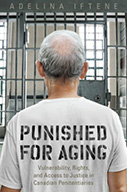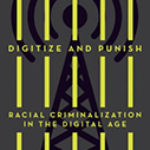Punished For Aging: Vulnerability, Rights, And Access To Justice In Canadian Penitentiaries

Author: Adelina Iftene
Publisher: Toronto: University of Toronto Press, 2019. 264p.
Reviewer: Helen Hudson | May 2021
Throughout the Western world the prison population is aging, giving rise to a range of ethical and practical issues for prison systems designed, physically, legally and administratively to hold younger and healthier prisoners.1 In Punished for aging: vulnerability, rights, and access to justice in Canadian penitentiaries, legal scholar Adelina Iftene analyses the experiences of older people incarcerated in the Canadian federal prison system. The book is based on a study comprised of interviews with 197 prisoners over the age for 50 at seven men’s penitentiaries across security classifications in Ontario, Canada’s largest province. Iftene states early on that her book has three aims: “to inform, to challenge and to start a conversation about reform” (p.8). While focussing on aging prisoners, she uses their experience as a case study to illuminate the conditions faced by any group of prisoners who are particularly vulnerable, and obstacles to reforming the Canadian federal prison system towards greater respect for the rights of all prisoners. Some scholars and activists have, however, questioned the overall viability of prison reform, pointing out that the prison’s oppressive character is inherent to its function as a social institution.2 Iftene herself characterizes Canadian prisoners as being “outcasts from our system of rights” (p.8), both in terms of their treatment within the legal system and the prison environment itself, quoting Supreme Court of Canada decision Sauvé vs. Canada (Chief Electoral Officer). This statement foreshadows the formidable obstacles that she goes on to describe throughout the book.
Iftene met significant methodological challenges in accessing the prisoners she interviewed for this study. Because of these constraints, readers should bear in mind the experiences of particular groups of aging prisoners whom Iftene was not able to include. Firstly, since she was only granted access to designated interview rooms, participation was limited to those able to reach those areas of the prison. Thus, anyone whose health prevented them from getting there or from sitting for the duration of the interview is not represented here. Notably, no one in the final stages of life-threatening illness was interviewed. Some participants, however, gave second-hand accounts of the experiences of their dying peers, and Iftene does include consideration of end-of-life care in her analysis. Secondly, since the study was carried out solely in men’s facilities, it is worth noting that resources and services in women’s prisons are often even more lacking, due to their much smaller population.3
Despite these limitations, Punished for Aging offers a thorough and well thought out exploration of the issues facing older prisoners. While her legal analysis is specific to Canada, many of the underlying issues she describes hold true across jurisdictions, particularly in the Western industrialized world, and all the more so to the degree that the prison system in the reader’s location resembles Canada’s (i.e., countries with demographic and historical similarities to Canada, and/or common law legal systems).
At the very outset of the book, readers are introduced to two of Iftene’s interviewees, John and Eric. Throughout the subsequent chapters, their stories are interwoven with background information, broader quantitative and qualitative findings of the study, short quotations from other participants, and Iftene’s analysis, providing an engaging narrative thread to the work. John is 59, though by Iftene’s account he looks as if he were in his seventies. This is consistent with the phenomenon of hyper-aging: that prisoners are physiologically ten years older than their counterparts in the community (hence many studies of older prisoners, including Iftene’s, define ‘old’ as 50 years or more). John has been in prison for 28 years on a twenty-five-years-to-life sentence, and has 17 chronic health conditions. His wife has died during his incarceration, and it seems likely that he will spend the rest of his life in prison. By contrast, Eric is serving a 5-year sentence, coming to prison for the first time in his seventies. As his wife’s main caregiver and the legal guardian of another relative, his greatest concern is for their well-being. Living with advanced multiple sclerosis as well as multiple other diagnoses including Parkinson’s disease and skin cancer, Eric has great difficulty negotiating day-to-day life inside the penitentiary. Their respective experiences illustrate two profiles of older prisoners, those serving long sentences who ‘age in place’ within the prison system, and those who are convicted later in life.
Chapter one provides an overview of the Canadian federal prison system, known as Correctional Service Canada or CSC, as well as the legal framework that regulates it. Anyone sentenced to two years or more is held within CSC facilities. At the time of writing, there were just over 14000 prisoners in CSC’s 43 penitentiaries. Twenty-five percent of them were aged 50 or over, and the percentage was (and is) growing. Of note, CSC is directly responsible for the healthcare of its prisoners. That is, primary healthcare is provided by on-site nursing staff employed by CSC who refer to staff doctors, dentists and psychotherapists. It also operates its own regional hospitals, as well as mental health facilities known as regional treatment centres. Prisoners are transferred to community hospitals for specialized treatment such as surgery or chemotherapy, when these are deemed necessary. Much of this chapter is devoted to describing the organization of CSC healthcare in detail, but Iftene also introduces CSC’s stated philosophy of reintegration, where prisoners are meant to ‘cascade down the security levels’ until their release into the community, by which point they would have completed a range of programs that prepare them for life outside prison. As particularly illustrated through Eric’s case, one of the major problems facing older prisoners is that pathways to release into the community are neither age- nor health-sensitive. Based on the length of his sentence, Eric could theoretically have already been paroled by the point when Iftene interviewed him. In order to be paroled, however, he was required to participate in a number of programs which his health prevented him from completing: his medication sedated him to the point where he could not stay awake in the sessions, and he was expelled from the program.
Chapter two, age and healthcare behind bars, outlines the ways in which prisons are unequipped to accommodate older people. It describes a number of issues including lack of systematic pain control, restricted access to medical diet and items (e.g., canes or incontinence products), people with dementia or other mental health conditions being placed in solitary confinement, buildings lacking hand rails or elevators, outdoor walkways not cleared of ice in the winter, and abuse of older prisoners by guards and other prisoners including their assigned peer caregivers. It is also in chapter two that Iftene presents the bulk of her quantitative findings, including numerous tables with prevalence of physical and mental health conditions, symptoms, and other health indicators. Although health data from self-reports are usually regarded as less robust than independently documented diagnoses, this aspect of the book represents a treasure trove of information for those interested in health within CSC facilities, given the difficulties external health researchers have had in accessing them. Iftene also presents statistical correlations between health status and various experiences, such as abuse by staff or peers and time spent in segregation. These data support her argument that greater physical frailty is associated with greater victimization.
In chapter three, reform for older prisoners: release and institutional accommodation, the author engages the question of what an age-responsive prison system might look like, and lays out CSC’s legal obligation in this regard. Here, the recommendations focus on mechanisms for release of older prisoners including compassionate release for those who are dying, as well as changes within CSC’s structure that could bring about respect of older prisoners, such as reorganization of health services provision and senior-only living units.
The remainder of the book is devoted to mapping out the various potential avenues for reform, both within and outside CSC as an institution. Iftene’s analysis is grounded in the history of struggles for prisoner justice in Canada over the past several decades. She draws conclusions from this history about the specific legal and administrative channels that are best suited to improve the conditions faced by older prisoners. Here the idea of prisoners as ‘outcasts from our system of rights’ returns to the fore, as she describes a prison system resistant to external oversight or scrutiny, and a court system biased against and inaccessible to prisoners. Oversight in fact exists through the Office of the Correctional Investigator (OCI), a government body independent of CSC. Iftene reports, however, that the OCI’s age-related recommendations have largely been ignored. One of the interviewees states: “I talked to many people over the last forty years…. They do their reports, they check the activity and then the resulting paper collects dust somewhere” (p.124).
Beyond oversight, prisoners can theoretically claim their rights before boards and tribunals such as the Canadian Human Rights Tribunal, and through CSC’s administrative grievance procedure. In principle these are more accessible to prisoners than the courts since they are free of charge and do not require in depth legal knowledge. As many in this study point out, however, the power relations and practicalities of being imprisoned make it almost impossible to access these tribunals in practice. A similar problem exists with the courts themselves — while a number of legal mechanisms already exist that could support greater dignity, better healthcare, and fairer treatment for older prisoners, they are rarely in a position to take legal action against CSC. Moreover, Iftene cites multiple cases to demonstrate that the courts are consistently less likely to believe prisoners than free community members making analogous claims.
Taken together, the chapters on reform can be interpreted either as a roadmap for a strategy to reform the prison system, or as a presentation of the barriers that make it unreformable. The latter reading starts from the assumption that the problems that prisoners (older or otherwise) face in being treated as fully human are social and political as well as legal, and must be addressed at those levels. Nonetheless, as Iftene’s vivid description reminds us, the immediacy of her interviewees’ suffering demands action. Her analysis points to strategic points of entry into making changes to the prison system – if only as a form of harm reduction on the path to more fundamental social transformation.
Whether readers come to Punished for Aging for the primary data or for the legal analysis, this book is an important work. Impressive both in its scope and its depth, it respectfully conveys the voices of a population who are too often invisible to those whose lives are not directly touched by the prison. As such, it makes a significant contribution to both the prisoner health and prisoner justice literatures.
References
(1) Richter, M., & Hostettler, U. (2017). End of Life in Prison: Talking Across Disciplines and Across Countries. Journal of Correctional Health Care 23(1): 11-19.
(2) Davis, A. (2003). Are Prisons Obsolete? New York: Seven Stories Press.
(3) Reviere, R. & Young, V. (2004). Aging behind bars: health care for older female inmates. Journal of Women & Aging, 16(1/2): 55-69.
Helen Hudson, PhD candidate, School of Nursing, University of Ottawa.


